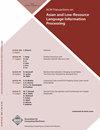BERT Inspired Progressive Stacking to Enhance Spelling Correction in Bengali Text
IF 1.8
4区 计算机科学
Q3 COMPUTER SCIENCE, ARTIFICIAL INTELLIGENCE
ACM Transactions on Asian and Low-Resource Language Information Processing
Pub Date : 2024-07-05
DOI:10.1145/3669941
引用次数: 0
Abstract
Common spelling checks in the current digital era have trouble reading languages like Bengali, which employ English letters differently. In response, we have created a better BERT-based spell checker that makes use of a CNN sub-model (Semantic Network). Our novelty, which we term progressive stacking, concentrates on improving BERT model training while expediting the corrective process. We discovered that, when comparing shallow and deep versions, deeper models could require less training time. There is potential for improving spelling corrections with this technique. We categorized and utilized as a test set a 6300-word dataset that Nayadiganta Mohiuddin supplied, some of which had spelling errors. The most popular terms were the same as those found in the Prothom-Alo artificial error dataset.利用 BERT 启发的渐进式堆叠技术加强孟加拉语文本的拼写校正
当前数字时代的普通拼写检查很难读懂像孟加拉语这样的语言,因为这些语言使用的英文字母各不相同。为此,我们利用 CNN 子模型(语义网络)创建了更好的基于 BERT 的拼写检查器。我们称之为渐进式堆叠的新技术集中于改进 BERT 模型的训练,同时加快纠正过程。我们发现,在比较浅层模型和深层模型时,深层模型所需的训练时间更少。这种技术有可能改进拼写纠正。我们对 Nayadiganta Mohiuddin 提供的 6300 个词的数据集进行了分类,并将其用作测试集,其中一些数据集存在拼写错误。最流行的词汇与 Prothom-Alo 人工错误数据集中的词汇相同。
本文章由计算机程序翻译,如有差异,请以英文原文为准。
求助全文
约1分钟内获得全文
求助全文
来源期刊

ACM Transactions on Asian and Low-Resource Language Information Processing
Computer Science-General Computer Science
CiteScore
3.60
自引率
15.00%
发文量
241
期刊介绍:
The ACM Transactions on Asian and Low-Resource Language Information Processing (TALLIP) publishes high quality original archival papers and technical notes in the areas of computation and processing of information in Asian languages, low-resource languages of Africa, Australasia, Oceania and the Americas, as well as related disciplines. The subject areas covered by TALLIP include, but are not limited to:
-Computational Linguistics: including computational phonology, computational morphology, computational syntax (e.g. parsing), computational semantics, computational pragmatics, etc.
-Linguistic Resources: including computational lexicography, terminology, electronic dictionaries, cross-lingual dictionaries, electronic thesauri, etc.
-Hardware and software algorithms and tools for Asian or low-resource language processing, e.g., handwritten character recognition.
-Information Understanding: including text understanding, speech understanding, character recognition, discourse processing, dialogue systems, etc.
-Machine Translation involving Asian or low-resource languages.
-Information Retrieval: including natural language processing (NLP) for concept-based indexing, natural language query interfaces, semantic relevance judgments, etc.
-Information Extraction and Filtering: including automatic abstraction, user profiling, etc.
-Speech processing: including text-to-speech synthesis and automatic speech recognition.
-Multimedia Asian Information Processing: including speech, image, video, image/text translation, etc.
-Cross-lingual information processing involving Asian or low-resource languages.
-Papers that deal in theory, systems design, evaluation and applications in the aforesaid subjects are appropriate for TALLIP. Emphasis will be placed on the originality and the practical significance of the reported research.
 求助内容:
求助内容: 应助结果提醒方式:
应助结果提醒方式:


